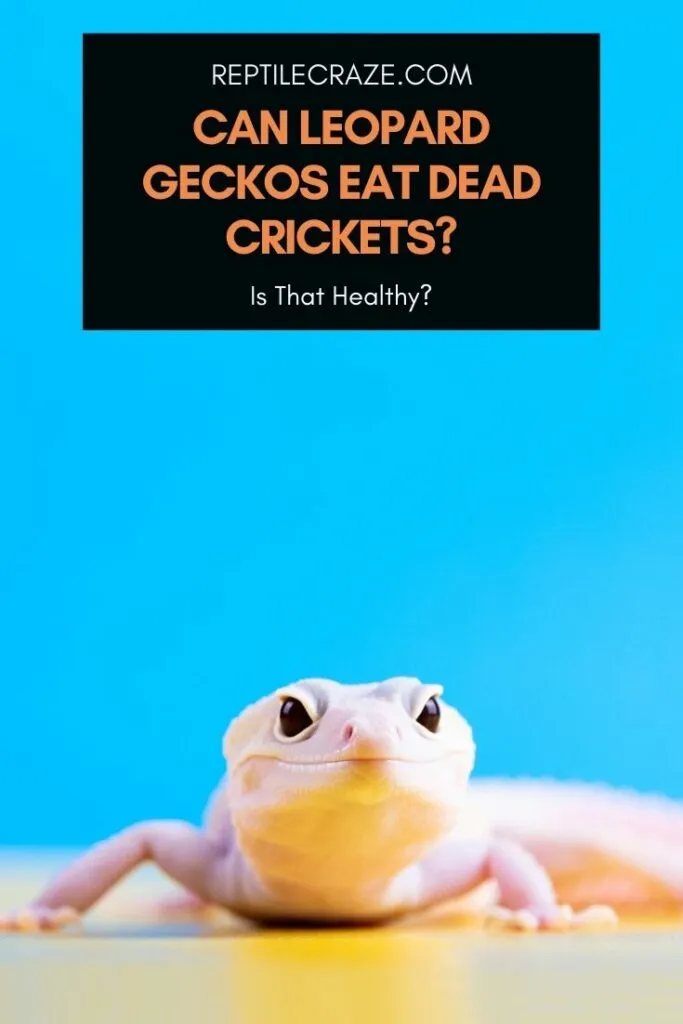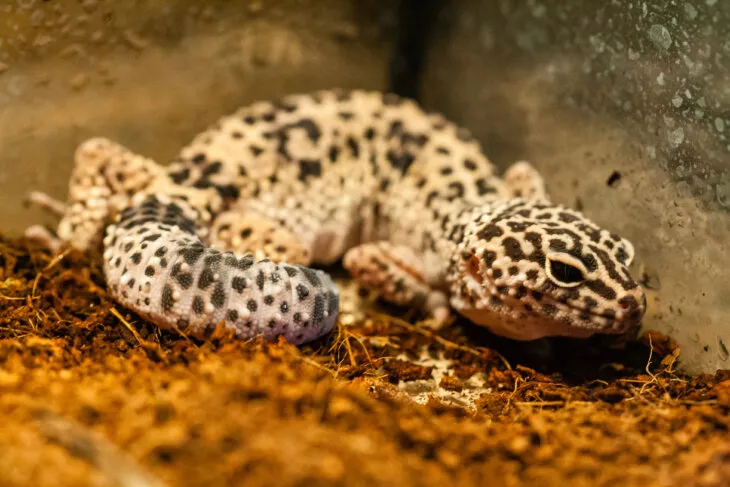
House crickets (Acheta domesticus) are among the most favored feeders for leopard geckos. As such, it’s not uncommon for reptile owners to buy live crickets in bulk for their geckos’ staple diet. But, when the insects start dying off, it’s natural for people to ask can leopard geckos eat dead crickets?
Feeding leopard geckos dead crickets is not recommended for several reasons. Dead crickets have little to no moisture or nutritional value. Besides that, dead crickets attract parasites and bacteria that can harm your gecko’s health.
If you’re on the hunt for answers relating to dead crickets, we can help. This article will highlight the dangers of feeding leopard geckos dead crickets, valuable pointers on assorted cricket types, and more.
Table of Contents
Is It Safe To Feed Leopard Geckos Dead Crickets?
Feeding a leopard gecko dead crickets isn’t safe or recommended based on various grounds. First off, dead crickets have little to offer, nutritionally speaking. (Live crickets actually have a very good nutritional value – we highly recommend reading our article on that here.)
Once the insect is dead, its moisture content tends to dry up, effectively removing all the necessary nutrients. Allowing your leo to eat dead crickets is just going to fill up its tummy and do nothing else.
The more worrying element of letting your gecko eat dead crickets is the presence of parasites and/or bacteria. A dead cricket will attract certain pathogens that help move the decomposition process along.
The problem is, those same microbes are still lingering on the cricket when your leo feeds on it, giving the toxins they create a free pass to enter your reptile’s body. This can lead to all sorts of health concerns that gecko owners want to avoid.
What’s more, if you’re housing your feeders in a cricket keeper, the live crickets may start ingesting the dead ones, leading to cross-contamination. That can eventually result in gecko owners having to dispose of the entire batch of insects.
In short, the best thing to do with dead crickets is to toss them out. Not all geckos will go after unmoving prey, and those that do will get nothing for their efforts.
Reptile enthusiasts should also be sure to remove dead crickets from the keepers (or pens) as these can contaminate live ones, and the ammonia produced by decomposition can lead to more crickets dying.

Can Leopard Geckos Eat Freeze-dried Crickets?
In comparison to dead and live crickets, freeze-dried ones fall in the middle of the nutrition spectrum. That means you can feed your leo freeze-dried crickets, but they’re not as nutritious as live ones.
Quite a few sources on the internet claim lyophilization removes all the nutrients from insects. That’s not entirely true.
Freeze-drying makes use of low-temperature dehydration and doesn’t rely on heat to evaporate water. The process involves freezing the product, lowering the pressure, and eliminating the ice.
Freeze-drying doesn’t degrade nutritional values too much, leaving the
When crickets are freeze-dried, they tend to lose some of their moisture content, which helps increase the protein quotient and increase the shelf-life. That means if your leo is willing, you can feed it freeze-dried crickets in moderation.
It’s best not to rely on freeze-dried insects entirely because they don’t offer much in terms of water, fat, or calcium content.
Tip: If you’d like to learn more about feeding your gecko dried crickets, go through our guide here.
How To Avoid Dead Crickets When Buying Online
If you want to buy live crickets for your leopard gecko, you should stick to known and reputable sources dealing in captive-bred feeders. These could be local stores or online sources like Josh’s Frogs.
It’s also essential to spend time researching the fine print of online websites and pay special attention to those offering live product guarantees.
Such guarantees can come in handy when shipping live feeders if the insects arrive at your doorstep damaged or dead. Buyers’ claims on insect shipments can help them get a free order to make up for the problematic one.
How To Keep Feeder Crickets Alive?
Geckos owners are a conscientious bunch, and there’s no way they’d think about feeding their leo dead crickets unless they’re in a tough spot.
These ‘tough spots’ generally result from live crickets dying off in large numbers, leaving gecko enthusiasts nothing on hand to feed their reptiles.
Luckily, we’ve compiled valuable tips for leo enthusiasts breeding crickets on how to keep the bugs alive for longer. All you need to do is scroll down to discover more:
- Don’t ever be tempted to place your cricket
tank near direct sunlight to provide your insects warmth. Crickets are somewhat sensitive to light and prefer dark spaces. - You’ll also need to maintain the
tank temperature between 76 to 89 F. Anything colder than this can trigger hibernation and, in extreme cases, lead to death. - Breeders should be mindful to keep water and
food in a crickettank round the clock. It’s also essential to keep changing tofood to keep it fresh, prevent bacteria from forming in thetank , and keep your crickets healthy. - Many crickets drown as they try to drink from their water dish. To put an end to this, place a damp sponge in a container in the corner of the cricket as a water source for the thirsty bugs.
- It’s essential to maintain hygiene in a cricket
tank . Clear out rottingfood immediately and clean thetank at least twice a month. Cricket poop and rottingfood can lead to an ammonia build-up in thetank , causing crickets to die really fast.
Final Thoughts
Geckos enthusiasts can sometimes mistakenly compare dried crickets to dead ones. This can lead to them being tempted to try and feed their leos dead crickets.
But the fact of the matter is, there’s a world of difference between the two. At the end of the day feeding your leopard gecko, live insects remain the best course of action.
A leopard gecko eating dead crickets can harm its health while being useless nutrition-wise. So why take chances with your pet’s well-being when live crickets are almost always available?
- Enchi Ball Python: A Unique and Stunning Morph of Python regius - March 27, 2025
- Emerald Tree Monitor: The Enigmatic Green Guardian of the Rainforest - March 26, 2025
- The Egyptian Cobra (Naja haje): A Fascinating Serpent - March 25, 2025
